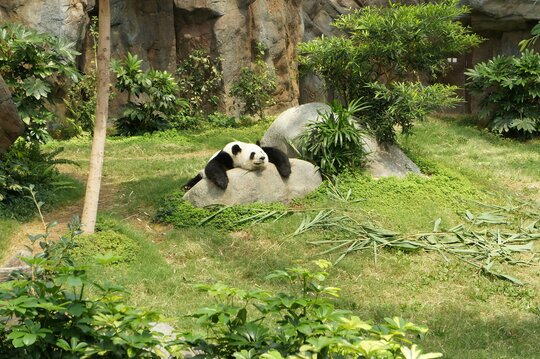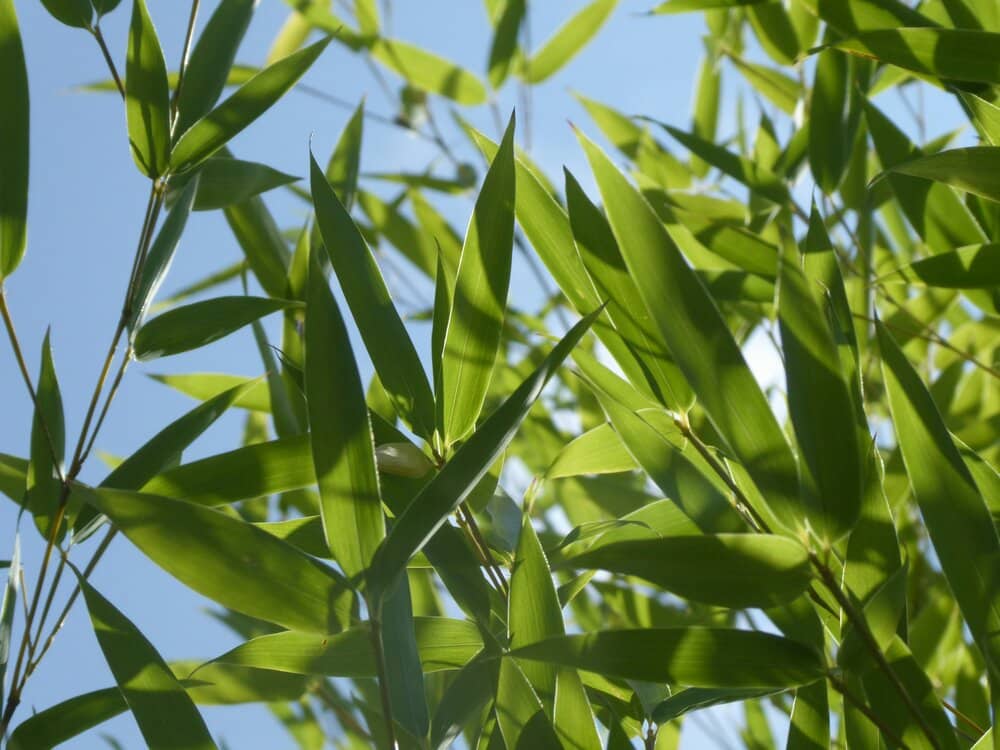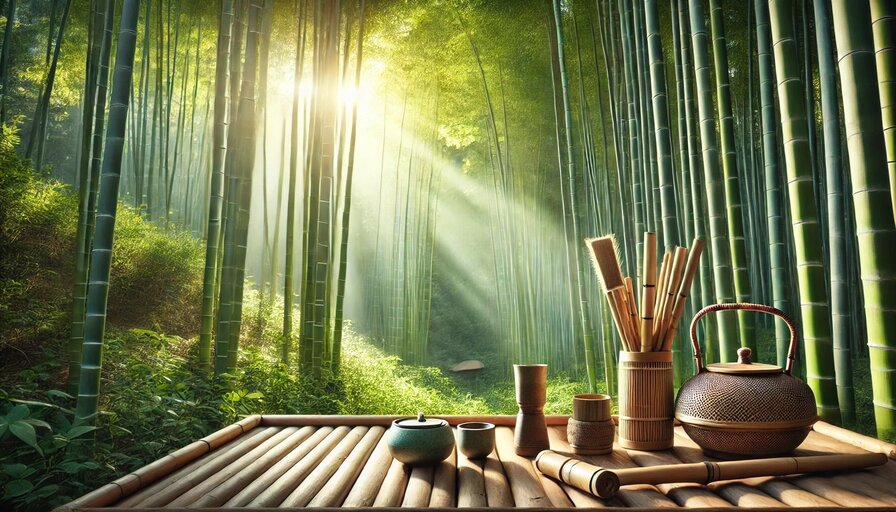Bamboo might not turn heads at first—but don’t let its simple looks fool you. This tall, green stalk has shaped homes, cultures, and even poetry for thousands of years. From ancient water vessels to today’s silky sheets, the history of bamboo is full of surprises.
So, how did something that grows wild in forests end up in your bedroom—or your kitchen, closet, or bathroom—as smooth, breathable bedding, soft towels, or reusable utensils? It’s a twist in the story that might just surprise you.
Covered Below
Bamboo: A Giant Grass with Global Roots
Bamboo’s not just the tall stuff swaying in the wind—it’s a grass with serious history. Before humans ever picked up a tool, bamboo was thriving across the globe, from humid forests in Asia to tropical zones in Africa and the Americas.
Fast Facts About Bamboo
Bamboo is technically a grass—there are over 1,400 species worldwide. Some can grow more than 3 feet in a single day, making it one of the fastest-growing plants on Earth.
The history of bamboo begins in prehistoric times. Fossil records show that bamboo has existed for tens of millions of years. Native to Asia, Africa, and parts of the Americas, it flourished in tropical and subtropical climates long before humans found uses for it. But once people discovered it? They didn’t waste any time putting it to work.
In early China, bamboo became essential for survival. Its hollow stems made perfect water containers. Its strength and flexibility lent itself to building shelters, rafts, and fishing tools. It was even used for writing long before paper—flat bamboo strips were tied together to form scrolls.
Over time, the plant found a place in nearly every aspect of daily life in regions where it grew. People across the globe found clever ways to use bamboo. In parts of South America and Africa, it was turned into baskets, shelters, and even tools for hunting. In India, it helped build homes and was woven into everyday items. In Japan, it played a key role in traditional gardening and fencing. Across Southeast Asia, it was shaped into kitchen tools, baskets, and even musical instruments.
Fun Facts about Pandas and Bamboo
Think you have a big appetite? Pandas might have you beat. A full-grown giant panda can eat anywhere from 26 to 84 pounds of bamboo a day—that’s like a human eating 200 bowls of salad every single day just to stay alive!
Learn more about their diet here and how bamboo supports more than just human needs.

Bamboo in Beliefs, Rituals, and Everyday Meaning
Bamboo isn’t just handy—it carries meaning too. Across the world, people have looked to this humble plant as a symbol of strength, simplicity, and good fortune.
In China, it’s long been admired for bending in storms without snapping—a quiet symbol of resilience. Writers often used it as a metaphor for staying strong during tough times.
In Japan, bamboo groves often grow near shrines, where they’re thought to keep away bad luck. Over in India, bamboo pops up in stories about new life and good luck—it’s even used in birth rituals and celebrations.
Because of these traditions, bamboo has woven itself into art, religion, and design. Even now, that symbolism shapes how we see bamboo in modern spaces—from minimalist interiors to sustainable product design.
A Timeline of Bamboo’s Role Through the Ages
Bamboo’s journey through history is anything but dull. Here’s a quick peek at some of the biggest moments.
Here are some key moments in the history of bamboo:
- 20th Century: Bamboo flooring and home goods gain popularity worldwide
- 5th Century BCE (China): Bamboo slips used as early writing surfaces
- Han Dynasty (206 BCE – 220 CE): Bamboo used for paper-making
- 7th Century (India): Bamboo woven goods and housing techniques develop
- 13th Century (Japan): Bamboo used in fencing and tea ceremony utensils
- 18th Century (Europe): Bamboo introduced as an exotic material for furniture and decor
A Chair Built Without a Single Nail
One of the most fascinating examples of bamboo craftsmanship comes from China—a chair built entirely without nails! Skilled artisans weave and fit bamboo pieces so precisely that the chair holds together naturally, relying only on the plant’s flexibility and strength. It’s a small but brilliant reminder of how bamboo has been trusted for centuries to create practical, beautiful things.
From Fish Traps to Fancy Sheets: Bamboo Reinvented
People have been turning bamboo into useful things for centuries, but these days, it’s taken a modern twist.
The practical uses of bamboo haven’t disappeared. If anything, they’ve expanded! Today, bamboo is used to make:
- Flooring and paneling
- Toothbrushes and kitchen utensils
- Clothing and accessories
- Bicycle frames
- And, of course, soft, breathable bamboo bedding
So how did we go from floating on bamboo rafts to sleeping under bamboo sheets? It comes down to what this plant does best—it grows like crazy, doesn’t need much water, and shrugs off pests. With the right processing, those sturdy stalks can be spun into fabric that’s soft enough to rival cotton. That’s where old-world usefulness meets modern comfort.
Want to know exactly how bamboo turns into soft fabric? Check out our step-by-step breakdown in How Bamboo Fabric is Made. Curious about how it stacks up comfort-wise? Read the full scoop in eco-friendly bamboo sheets. And if you’re comparing materials, don’t miss my article on bamboo vs cotton vs linen vs silk sheets.
Bamboo Bedding: The Comfiest Twist in Bamboo’s Long History
Who would’ve thought a plant once used to carry water is now something people sleep on?
Bamboo bedding might seem like a recent trend, but it’s just the latest in a long line of bamboo uses. What makes it special?
- Softness: Bamboo sheets feel smoother than cotton.
- Cooling Properties: They wick away moisture and help regulate temperature.
- Sustainability: Bamboo lyocell (a cleaner type of bamboo fabric) is made in closed-loop systems that reuse water and solvents.
- Hypoallergenic: Naturally resists dust mites and allergens.
Modern bamboo bedding brings together centuries of material innovation with today’s eco-conscious lifestyle. It’s a great example of how the history of bamboo continues to shape what we value in comfort and design.

Bamboo’s Eco Benefits: Ancient Roots, Modern Perks
Some things haven’t changed—bamboo is still one of the greenest plants around.
While our uses for bamboo have changed, one thing hasn’t: its environmental benefits.
- Regrowth: Bamboo can regrow from its own root system, which means no replanting is needed.
- Speed: Some species grow up to 3 feet per day.
- Carbon Absorption: Bamboo pulls carbon dioxide out of the atmosphere more efficiently than many trees.
These qualities made bamboo valuable in ancient times and even more relevant now. But it’s important to be aware that not all bamboo products are created equal. Bamboo viscose, for example, is often produced using chemical-heavy methods. That’s why certifications like OEKO-TEX and FSC are helpful when shopping for eco-friendly bamboo sheets.
Bamboo in Daily Life: Old Tricks, New Tools
Let’s take a quick side-by-side look at how people used bamboo back then—and how we’re still using it now.
Let’s take a look at how some traditional bamboo uses have evolved:
| Historical Use | Modern Equivalent |
|---|---|
| Water carrying tubes | Reusable bamboo water bottles |
| Handwritten scrolls | Bamboo paper products |
| Construction | Bamboo flooring and scaffolding |
| Woven baskets | Bamboo storage boxes |
| Sleeping mats | Bamboo mattress toppers and sheets |
The history of bamboo isn’t just about the past—it’s a living tradition. Many of the things we use today still reflect techniques and materials developed centuries ago.
Frequently Asked Questions About the History of Bamboo
- How long have people been using bamboo? For thousands of years. Its earliest documented use dates back to ancient China, around 5,000 years ago.
- What kinds of things was bamboo used for in ancient times? It was used for building, writing, cooking, carrying water, and making tools, furniture, and musical instruments.
- Why did bamboo matter so much in Asia? Because it was strong, lightweight, fast-growing, and incredibly versatile. Plus, it was abundant.
- What do we use bamboo for today? In addition to its traditional uses, it’s now found in textiles, packaging, kitchenware, and even electronics and cars.
- How does bamboo’s long history connect to today’s bedding? Bamboo bedding carries on the plant’s legacy of usefulness and comfort. It uses the same raw material in a new way, combining ancient sustainability with modern softness.
The History of Bamboo Isn’t Finished
Bamboo’s been part of human life for ages—but its story isn’t stuck in the past. In fact, it’s picking up speed.
With climate change, limited resources, and a growing demand for sustainable options, bamboo is stepping into the spotlight again. Its ability to grow fast, use fewer resources, and still carry deep cultural meaning makes it more than a passing trend—it’s a smart choice for the future.
From old-school water pipes to modern bedding, bamboo keeps finding new ways to fit into everyday life. And as more people look for greener ways to live, this humble plant’s story just keeps growing.

